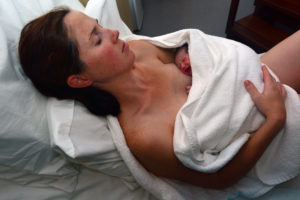Privacy in the Birth Environment
Introduction
Research is evident and growing that the environment in which women birth plays a significant role in the experience and outcome of labor and birth for both women and their families. Many birth professionals, working with laboring women develop an opinion regarding the optimum birth environment often in stark contrast to that of the design put in place in most hospitals. Architects focus on design centered around potential emergencies and the modern health care environment, while midwives focus on comfort, privacy and familiarity needs. Research has shown that women birthing at home or in home like environments have increased spontaneous vaginal deliveries, decreased analgesia and anesthesia, decreased oxytocin augmentation requirements and feel more satisfied with their birth.

What is Privacy?
The word private is found often alongside and associated with the words familiar, comfortable and safe when looking at birth space. The definition of private is individual, but multidimensional, incorporating physical privacy, the accessibility of self to others, physical space and control over this. Psychological privacy relating to emotions, individuality and our right to privacy, social privacy, control over settings and people within contact. With informational (medical records) privacy, generally being the most well known to health professionals. Privacy is a sense of self need, respect, trust and calmness, which can be created through concepts including layout and environmental such as lighting and music. It is essential for a woman to feel they are in a private space to ensure a positive hormonal feedback circuit and is the first recommendation in World Health Organizations (2018) Guide to a positive birth. Privacy, confidentiality, being free from harm are basic tenets of nursing and midwifery practice, it is a basic human right.
Hormones required for birth are the same as required for sex. When a woman feels safe, private and comfortable she is able to follow her innate, biological process of orgasming, laboring and birthing. When relaxed, her body releases oxytocin to facilitate contractions to begin and build, her beta endorphins work to produce an altered state of consciousness as an adaptive response to pain. Epinephrine works to increase cortisol and central oxytocin thereby promoting effective contractions whilst maintaining her sense of calm. Oxytocin activates the parasympathetic nervous system, promoting calm connection, and release of central oxytocin into the blood stream as well as endorphins creating a natural analgesia. When a stress response occurs whether from an actual or a perceived threat – when women don’t feel safe, private or in control, oxytocin release drops, activating a sympathetic system response, affecting the rhythm of labor. Stress increases beta endorphins to extensive levels and releases epinephrine-norepinephrine prior to their designed spike during second stage. Contractions may become slow, stop, or irregular – they may continue but with increased pain as her body works in two different directions. When labor rhythm is disturbed it is easy for a woman to experience increased stress escalating and experiencing higher levels of pain creating a negative feedback loop. Women may become emotionally unsettled when moving from their home environment to hospital, therefore they should feel safe and private as quickly as possible on arrival.
Ideas for enhancing Privacy in the Birth Environment
- Dim Lighting
- Closed Doors, windows and curtains
- Moving furniture to create a nest
- Utilise the bathroom area
- Creating familiarity – scents, pillows, bedding, food, drinks, heat packs etc.

Water Immersion
Water immersion provides an opportunity for safety and privacy, as the bath is a woman’s space, the water providing a barrier between her and those around her, the edge providing an opportunity for her to reach out to her support when required. While research does not show a considerable advantage to women of water immersion in labor, it is proven that relaxation has a direct effect on delivery outcome and a bath is a popular tool in many situations for women to achieve this. Laboring in water is associated with less epidural analgesia, decreased duration of labor, and is not associated with an increased risk to baby or mother in regards to outcomes such as mode of birth or nursery admission. As discussed earlier, the impact of less epidurals and shorter labors significantly impacts a woman’s natural hormone progression and ongoing risks. Epidurals increase the risk of augmentation with oxytocin, longer second stage and instrumental birth by effectively turning off the woman’s sensation feedback. Epidurals decrease oxytocin release, beta endorphins and epinephrine-norepinephrine, reducing contractions and central oxytocin, effectively removing her natural analgesia, her sense of calm and relaxation. Water immersion is associated with enhanced pain relief satisfaction and the overall birthing experience.

Conclusion
It is essential that women have a private, safe haven to labor and birth their babies. Often, however, they are confronted with a very medicalised, unfamiliar environment activating their fight or flight response and creating a lasting impact on labour, affecting both mother and baby adaptation and transition to postpartum life. Increasing women’s options and encouraging her to use alternatives, while also facilitating the comfort and confidence of the health professionals caring for her if an emergency were to occur. Privacy is a basic right of all human beings and with research present to support its importance in the natural progression of labor, it’s facilitation should be a priority for hospital birthing units.
